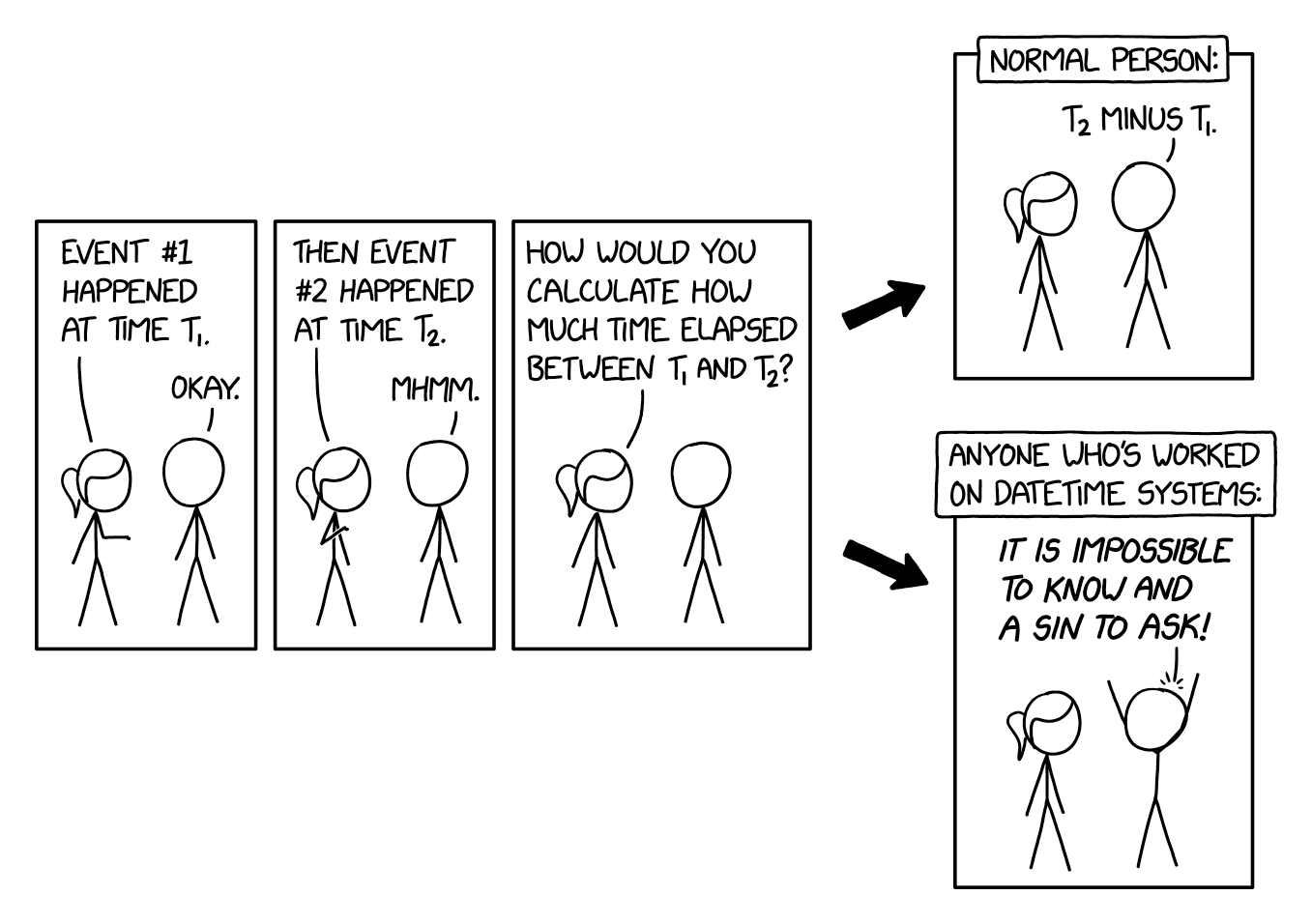OMG, it’s so trivial. What you do is when T2 happens you send an atomic clock back in time to T1 and start counting till T2 happens again. If T1 and T2 happen in different locations you send two entangled clocks and collapse the state on T2 clock when the event happens measuring the exact moment on T1. How is this an issue?
- Ok, but the time on the server clock and time on the client clock would never be different by a matter of decades.
- The system clock will never be set to a time that is in the distant past or the far future.
Does this come up? I feel like if you’re doing retrocomputing you assume a certain level of responsibility for your software breaking.
- Ok, but the duration of one minute on the system clock will be pretty close to the duration of one minute on most other clocks.
- Fine, but the duration of one minute on the system clock would never be more than an hour.
- You can’t be serious.
You can’t be, can you? Ditto on that being the user’s problem. My thing also isn’t portable onto Zeus Z-2 or a billiard ball computer you built in your garage.
There’s some weird shit in the crowdsourced ones. I don’t even know where to start.
You heard of standby and the likes? What do you recon that does to programs calculating with time in that exact moment?
I… Actually don’t know.
The real time clock continues to move in real time under reasonable conditions. If it’s in a weird year it’s either because you’ve decided to run a disk you found in a cave, left by the Ancient Ones, or you’re cheating at Animal Crossing.
I’m a little unclear on how the rest of the clocks typically work together. If your program is drawing from one that gets stopped for a while, I guess yeah, a minute could totally be weeks long, and I’m in the picture as a falsehood believer.
T2 - T1 = 'a while'Or anyone who has worked with general relativity
Actually, while mathematically heavy, it’s easy to measure in GR, assuming you’ve got a metric solved (If you don’t, you’re fucked. That shit is intractable to the point where you can name every exact solution on one page, and inexact solutions can just be lies) However, you may have to ask additional questions about what sort of time you want, which probably stems from why you need it.
The past is the past. Everything that happened before time
t_nowshould be set toInf. I thank you for your ears.I mean, as long you only need the delta in milliseconds it’s easy. Just count the milliseconds from 1970 to the event. The problem starts when you want to have a human readable representation.
It’s calenders they suck, not time.
Well… unless you measure the number of [milli]seconds using something like time_t, which lies because of leap seconds. I.e. even such a seemingly simple interface, in fact, includes a calendar.
Only problem is accepting dates in anything except YYYYMMDD, or unix time stamps if you need more precision.
Neither of those will solve the problem in the comic.
EDIT: NVM I’m a goddamn idiot, Unix Time’s handling of leap seconds is moronic and makes everything I said below wrong.
Unix Time is an appropriate tool for measuring time intervals, since it does not factor in leap seconds or any astronomical phenomenon and is therefore monotonously increasing… If
T1and/orT2are given in another format, then it can get very hairy to do the conversion to an epoch time like unix time, sure.The alt-text pokes fun at the fact that due to relativity, at astronomical scales then time moves at different speeds. However, I would argue that this is irrelevant as the comic itself talks about “Anyone who’s worked on datetime systems”, vanishingly few of which ever have to account for relativity (the only non-research use-case being GPS AFAIK).
While the comic is funny, if:- Your time source is NTP or GPS
- “event 1” and “even 2” both happen on Earth
- You’re reasonably confident that the system clock is functioning properly
(All of which are reasonable assumption for any real use-case)
Then((time_t) t2) - ((time_t) t1)is precise well within the error margin of the available tools. Expanding the problem space to take into account relativistic phenomena would be a mistake in almost every case and you’re not getting the job.Unix time fails to work for the ‘simple’ case of timezones entirely. It’s not meant for timezone based data and therefore unixtime in one timezone subtracted from unix time in another timezone will most likely give completely incorrect results. Even in the same timezone it will give incorrect results, see the ‘simple’ case of a country jumping across the international date line. Typically they skip entire days, none of which unix time will account for, as that would require not just time zone data, but location data as well.
You misunderstand what Unix Time is. It’s the number of seconds since 1970-01-01T00:00+00:00. It’s always relative to UTC. And the number of seconds since epoch is always the same regardless of where you are on Earth.
As I write this it’s
1702600950for you, for me, and in Sydney. Timezones (and DST, and leap seconds, and other political fuckery) only play a role once you want to convert1702600950into a “human” datetime. It corresponds to2023-12-15 00:46:02 UTCand2023-12-14 16:46:02 PST(and the only sane and reliable way to do the conversion is to use a library which depends on the tzdata).








